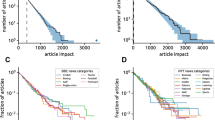Abstract
In many papers, the influence of growth on obsolescence is studied but a formal model for such an influence has not been constructed. In this paper, we develop such a model and find different results for the synchronous and for the diachronous study. We prove that, in the synchronous case, an increase of growth implies an increase of the obsolescence, while, in the diachronous case, exactly the opposite mechanism is found. Exact proofs are given, based on the exponential models for growth as well as obsolescence. We leave open a more general theory.
Similar content being viewed by others
References
M. B. Line, The ‘half-life’ of periodical literature: apparent and real obsolescence,Journal of Documentation, 26 (1970) 46–54.
B. C. Brookes, The growth, utility, and obsolescence of scientific periodical literature,Journal of Documentation, 26 (1970) No. 4, 283–294.
Gilda Gama De Queiroz, F. W. Lancaster, Growth, dispersion and obsolescence of the literature: a case in thermoluminescent dosimetry,Journal of Research Communication Studies 2 (1979–1981) 203–217.
M. R. Oliver, The effect of growth on the obsolescence of semiconductor physics literature,Journal of Documentation, 27, (1971) No. 1, 11–17.
M. B. Line, A. Sandison, ‘Obsolescence’ and changes in the use of literature with time,Journal of Documentation, 30 (1974) No. 3, 283–350.
A. Sandison, References/citations in the study of knowledge,Journal of Documentation, 31 (1975) No. 3, 195–198.
E. R. Stinson,Diachronous vs. Synchronous Study of Obsolescence, Ph. D. Thesis, 1981.
E. R. Stinson, F. W. Lancaster, Synchronous versus diachronous methods in the measurement of obsolescence by citation studies,Journal of Information Science, 13 (1987) No. 2, 65–74.
I. K. Ravichandra Rao, B. M. Meero, Growth and obsolescence of literature: an empirical study,Proceedings of the Third International Conference on Informetrics,I. K. R. Rao (Ed.), Bangalore (India), August 1991, pp. 377–394, 1992.
D. P. Wallace, The relationship between journal productivity and obsolescence,Journal of the American Society for Information Science, 37 (1986) No. 3, 136–145.
L. Egghe, I. K. Ravichandra Rao, Classification of growth models based on growth rates and its applications,Scientometrics, 5 (1992) No. 1, 5–46.
L. Egghe, I. K. Ravichandra Rao, Citation age data and the obsolescence function: fit and explanations,Information Processing and Management, 28 (1992) No. 2, 201–217.
Author information
Authors and Affiliations
Rights and permissions
About this article
Cite this article
Egghe, L. On the influence of growth on obsolescence. Scientometrics 27, 195–214 (1993). https://doi.org/10.1007/BF02016550
Received:
Issue Date:
DOI: https://doi.org/10.1007/BF02016550




